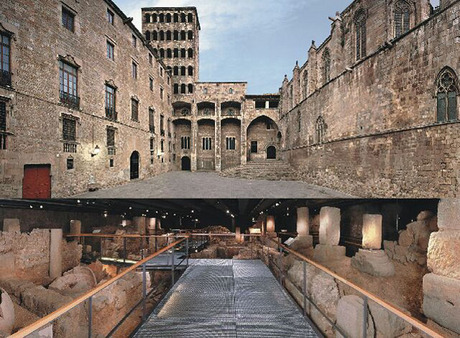Catalonia History Museum
The Catalonia History Museum, or MHCAT (Museu d'Història de Catalunya) offers a fascinating insight into Catalonia's past in a converted former dockside warehouse. The Catalonia History Museum is one of Barceloneta's most interesting cultural attractions.
The Museu d'Història de Catalunya impressively shows the history of Catalonia from the Stone Age to the present day. The Museum of the History of Catalonia is located on Old Port (Port Vell), on the edge of the district Barceloneta and Barri Gòtic.
Catalonia once had a trade empire to rival Venice's or Genoa's of which Barcelona was the capital. This, together with its Roman foundations, the story of its brutal subjugation during the Spanish War of Succession and the oppressive Franco years, provides the basis of a series of wonderful exhibitions charting the development of this intriguing region of Spain.
The Catalonia History Museum's permanent exhibitions cover eight different periods during Catalonia's history. Among the most interesting is Raices (Roots), which explores the earliest traces of human activity in the area, from the Lower Paleolithic Era over 450000 years ago, through Bronze Age Iberian civilization, Roman conquest and the arrival of the Visigoths.
Another fascinating section is Birth of a Nation, which plots the course of the formative years of a Catalan national identity, under duresse from the threat posed by Moorish invaders. Nuestro Mar (Our Sea) is an exhibiition dedicated to the trade empire Catalonia enjoyed in the eastern Mediterranean, when the Balearic Islands, Sardinia and Naples were all under Catalan control.
There's an ever-changing roster of visiting exhibitions at the Catalonia History Museum. Topics covered include anything from Catalan Post-Civil War usic to the way the Costa Brava was before the ravages of tourist development changed it forever during the twentieth century. There's also a cafe-terrace, an auditorium, a historian's workshop, a library and a restaurant.
The building is a brick house, which was used as a warehouse in the 19th and 20 Century. At the Olympic Games in 1992 the building was renovated and expanded and the Museu d'Història de Catalunya moved to new premises. In the museum no significant findings are discovered, but the presentation is very modern and multimedia processing. You get a very good overview of the history of Catalonia.
The building that we know today as the Palau de Mar is the former General Stores, the sole building of Barcelona's Old Port still standing. The Stores were designed in 1881 by the engineer Mauricio Garrán, the first director of the Barcelona Port Board of Works, and were intended for use as trading depots. Today it houses the Museum of Catalonian History (Catalan: Museu d'Història de Catalunya)
The General Stores building is an example of the conceptually most innovative construction techniques of the period from the late 19th century to the early 20th. The Stores have a double structure. The interior structure consists of a rolled steel framework while the exterior structure is brickwork. The interior structure is highly effective in spaces that need to be both open and bear heavy loads, while the brickwork exterior provides excellent protection for the goods against bad weather, fire and theft.
The increased use of metal structures over a century ago coincided with the emergence of the flat roof, both of which are used to good advantage in the construction of the Stores. Mechanised casting made it possible not only to save material but also to more closely adapt the form to the function. Flat roofs are lightweight, resistant and ribbed, and dry-bond perfectly to the base and other components without the need for mortar.
Two types of support are used in the Stores: cast-iron columns and rolled steel columns. Pins are the most commonly used linking component. Both the columns and the beams were made in the workshop. Once on site, these large components were assembled and joined together using cold-threaded bolts.
The building was refurbished in 1992 by the architects Josep Benedito and Augustí Mateos, resulting a major transformation of the Stores, blending the port tradition with the dynamism of contemporary architecture and establishing a dialogue between the old and the new. Firstly, a large open space was created in the centre of the building to make it seem lighter and at the same time to allow for vertical circulation within it. Secondly, a new floor was added in order to allow access to the rooftop, which has been acclaimed as a great success as it enables visitors to enjoy fabulous views of the port and the city. The Catalonia History Museum is great for sightseeing and taking photos.
If you're interested in learning more about the history of Catalunya this is one of the museums in Barcelona that will be of interest to you. It has many interesting exhibitions that deal with different periods of Catalunya's history. This museum has taken a proactive approach to displaying artefacts and has designed many exhibits that allow you to interact with the displays.
This remarkable museum is devoted to the history of the Catalonian region, which includes this area of Spain and also an area of South East France, and the history of Catalunya as a nation. The Catalonia History Museum is easily accessed via a three minute walk from Barceloneta Metro Station (Yellow Line). If you want to know and understand everything from Catalunya and of course, Barcelona as its capital city, this is one of the first places for you to visit. You can get there via direct flight to Barcelona or to Girona, Reus or Lleida–Alguaire.
Only in Barcelona people can enjoy the sunny beaches and the sea and after five minutes they can be visiting a museum. La Barceloneta is the heart of the city where people gather in the hot days of the summer. There are plenty of hotels and appartments to stay close to the beach. After your flight to Barcelona, don't forget to book a reservation. From there you can easily visit the Catalonia History Museum and enjoy its sights.




